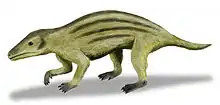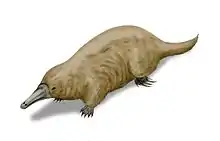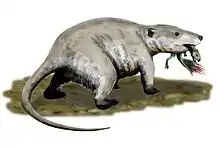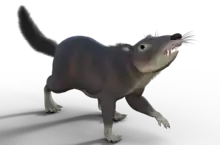Spalacotherium
Spalacotherium is a genus of extinct mammal from the Early Cretaceous of Europe. The type species Spalacotherium tricuspidens was originally named by Richard Owen in 1854, and its material includes maxillary and dentary fragments and many teeth from the Berriasian Lulworth Formation of southern England. Referred species include S. taylori, S. evansae and S. hookeri also from the Lulworth deposits, and S. henkeli from Barremian deposits of Galve, Spain.[2][3][1] The Lulworth taxon Peralestes longirostris, named by Owen in 1871, is a junior synonym of the type species S. tricuspidens. Spalacotherium is the namesake taxon of the family Spalacotheriidae, which is an extinct clade within Trechnotheria that may be closely related to the Gondwanan clade Meridiolestida,[1] or united with the family Zhangheotheriidae to form Symmetrodonta.[4]
| Spalacotheriidae |
| ||||||||||||||||||||||||||||||||||||||||||||||||||||||
| Spalacotherium | |
|---|---|
| Scientific classification | |
| Kingdom: | Animalia |
| Phylum: | Chordata |
| Class: | Mammalia |
| Order: | †Symmetrodonta |
| Family: | †Spalacotheriidae |
| Genus: | †Spalacotherium Owen, 1854 |
| Species | |
| |
| Synonyms[1] | |
| |
References
- Averianov, A.O.; Martin, T.; Lopatin, A.V. (2013). "A new phylogeny for basal Trechnotheria and Cladotheria and affinities of South American endemic Late Cretaceous mammals". Naturwissenschaften. 100 (4): 311–326. Bibcode:2013NW....100..311A. doi:10.1007/s00114-013-1028-3. PMID 23494201. S2CID 18504005.
- Ensom, P.C.; Sigogneau-Russel, D. (2000). "New symmetrodonts (Mammalia, Theria) from the Purbeck Limestone Group, Lower Cretaceous, southern England". Cretaceous Research. 21 (6): 767–779. doi:10.1006/cres.2000.0227.
- Gill, P. (2004). "A new symmetrodont from the Early Cretaceous of England". Journal of Vertebrate Paleontology. 24 (3): 748–752. doi:10.1671/0272-4634(2004)024[0748:ANSFTE]2.0.CO;2.
- Han, G.; Meng, J. (2016). "A new spalacolestine mammal from the Early Cretaceous Jehol Biota and implications for the morphology, phylogeny, and palaeobiology of Laurasian 'symmetrodontans'". Zoological Journal of the Linnean Society. 178 (2): 343–380. doi:10.1111/zoj.12416.





